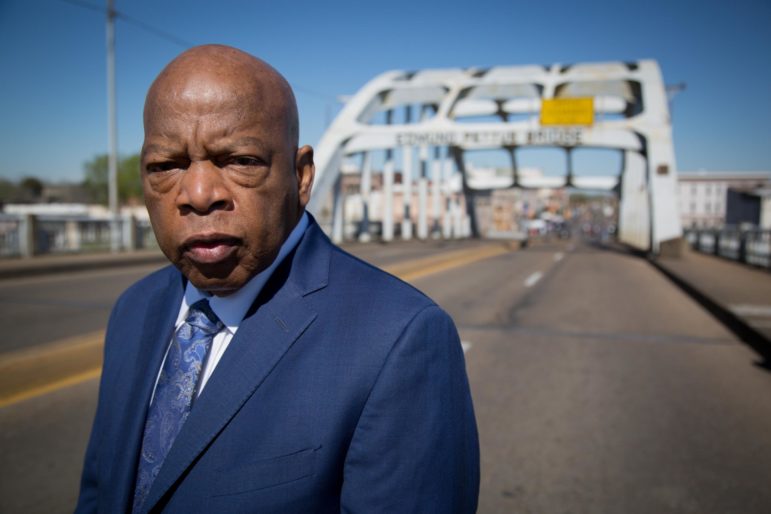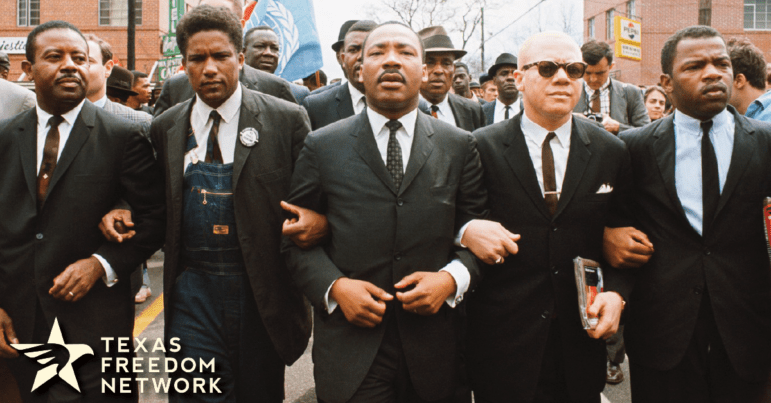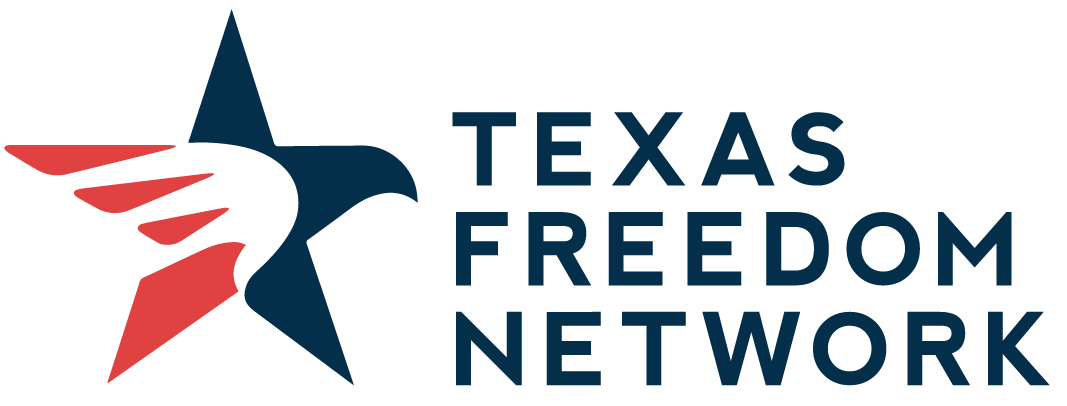“My dear friends: Your vote is precious, almost sacred. It is the most powerful nonviolent tool we have to create a more perfect union.”
John Lewis, Civil Rights Leader, Freedom Rider, and U.S. Congressman
This Black History Month, the Texas Freedom Network and its program for young Texans, Texas Rising, are focusing on the decades-long fight that folks in the Black community have led to ensure the right to vote for everyone.
While there have been major wins in the past 60 years, we are living in an intensely tumultuous time for democracy when state legislatures across the country, including ours in Texas, move to make voting harder than it should be. During these renewed attacks, we are called to reflect on the history of voting rights.
We’ve put together a timeline of how every citizen gained the right to vote, as well as the wins and losses we’ve experienced along the way.
Voting Rights in America: A Timeline
October 7, 1963 – Freedom Day
- In October 1963, two months after the March on Washington, local citizens and activists gathered in solidarity at the Dallas County courthouse in Selma, Alabama. The line of men and women for the Registrar’s Office stretched down the steps of the courthouse and all the way into the street–each an American citizen hoping to register to vote. The county was 58 percent Black, yet less than 1 percent of Black citizens in the county were registered to vote. As the line grew to 250 people by 11 a.m. (people had been lining up since dawn), Dallas County Sheriff Jim Clark and his armed deputies were closely watching the gathering crowd–growing increasingly irritated, they began arresting and beating people attempting to bring food and water to those in line. Registrars worked slowly that day–only registering a few voters each hour. At 12:30 p.m., a group of 40 state troopers arrived to aid Clark and his deputies in voter intimidation, a blatant violation of the 1957 Civil Rights Act.
Summer of 1964 – Freedom Summer (Mississippi Summer Project)
- Freedom Summer, or the Mississippi Summer Project, was a voter registration drive aimed at growing the number of registered Black voters in the state. Over 700 volunteers joined the Black community in the fight against voter suppression, intimidation, and discrimination at the polls. Just like Freedom Day, activists were met with violent resistance from both local and state law enforcement–as well as the Ku Klux Klan. News coverage of these egregious civil rights violations–beatings, false arrests, even murders–drew international attention to the movement.
January 1965 – Selma Voting Rights Campaign
- In January 1965, Dr. Martin Luther King joined the activists in Selma who had been working tirelessly to register voters in Dallas County. At this time, only 2 percent of Black citizens in the county were registered – up just 1 percent from the two years before. Dr. King, the SCLC, and the SNCC hoped that the notorious brutality of Selma law enforcement might garner attention from President Lyndon B. Johnson and pressure Congress to enact national voting rights legislation.
- In the first month of the campaign, many arrests occurred without violence. That changed in February when police attacks against nonviolent protesters increased–on Feb. 18, white segregationists attacked the peaceful group. In the chaos, an Alabama state trooper shot and killed Jimmie Lee Jackson, a young church deacon attempting to shield his mother from a trooper’s nightstick. The 26-year-old died eight days later in a hospital. In response to his death, activists planned a march to the state capitol in Montgomery, which would be led by John Lewis and Hosea Williams while Dr. King was in Atlanta.
Ensuring the voting rights of every citizen is central to our mission at TFN.
Join our movement today.
March 7, 1965 – Bloody Sunday
- Jackson’s death became the rallying cry for activists who had continually experienced violence at the hands of segregationists and law enforcement—all for attempting to register Black voters and peaceful protest. On March 7, 1965, organizers journeyed on foot through Selma and across the Edmund Pettus Bridge. On the bridge, a blockade of state troopers wielding whips, clubs, and tear gas attacked them, resulting in activists retreating as a group of white onlookers cheered the violence. The coverage triggered national outrage, and the event was became known as “Bloody Sunday.”
March 21, 1965 to March 25, 1965 – Selma to Montgomery March
- After Bloody Sunday, Dr. King went straight to work organizing another march. Although members of the movement wished to mobilize immediately, President Johnson urged Dr. King to wait for a federal court order that would ensure the activists’ protection from law enforcement and segregationists. On March 17, Johnson submitted his voting rights legislation to Congress, and on March 21, Dr. King began the march from Selma, arriving at the capital in Montgomery on March 25. They covered 7-17 miles per day, and the number of demonstrators reached around 25,000 by the final day.
“Today I want to tell the city of Selma, today I want to say to the state of Alabama, today I want to say to the people of America and the nations of the world, that we are not about to turn around. We are on the move now… Yes, we are on the move, and no wave of racism can stop us.”
Dr. Martin King Luther, Jr., Rally at the Alabama State Capitol
August 6, 1965 – Voting Rights Act Signed by President Johson
- Nearly four months after the march from Selma to Montgomery, President Johnson signed the Voting Rights Act into law in the presence of Dr. King and other civil rights leaders. The landmark legislation eliminated literacy tests and poll taxes created to discourage Black voters and gave the federal government more oversight to ensure free and fair elections. The next day, Johnson’s attorney general also initiated lawsuits against four states refusing to comply.
“Selma is a place where we injected something very meaningful into our democracy. We opened up the political process and made it possible for hundreds and thousands and millions of people to come in and be participants.”
Representative John Lewis, Oral history interview conducted by the House historian, Dec. 11, 2014
Current Day

Since 1965, the victories achieved by civil rights leaders have continuously faced challenges–from shifting the cultural norms around voting to navigating obstacles designed to make voting difficult for minorities.
Below are just some of the barriers created to suppress the votes of marginalized communities and the actions taken in response by voting rights advocates today:
June 25, 2013 – Shelby County v. Holder
- U.S. Supreme Court rules Section 4(b) of the Voting Rights Act is unconstitutional, giving more power to the states to create restrictive voting laws like early polling place closures, stringent voter ID laws, limiting early voting, and more.
March 2019 – Stacey Abrams Launches Voting Rights Nonprofit
- After a deeply contested loss to Brian Kemp during the 2018 Georgia gubernatorial election, Stacey Abrams launches FairCount, a nonprofit organization aimed at ensuring all populations in Georgia were counted in the 2020 U.S. Census, a move that made redistricting efforts more equitable. The organization has also challenged Georgia’s electoral policies in court.
2021 – Various Restrictive Voting Laws Introduced
- After false allegations of widespread voter fraud following the 2020 presidential election, 19 states passed 34 laws aimed at restricting voting rights. That’s in addition to the 440 laws across 49 states that were proposed in 2021. Some restrictions include limiting vote-by-mail, and stricter voter ID laws. SB 1, a Texas bill, is said to be one of the most restrictive voting bills in the country. It makes it harder for voters with disabilities and language barriers to get assistance, bans drive-thru voting, and even constrains poll workers’ ability to stop harassment at the polls.
August 2021 – John R. Lewis Voting Rights Advancement Act of 2021
- U.S. Rep. Terri A. Sewell, D-Ala., introduces a bill that would strengthen the 1965 Voting Rights Act and replace the section struck down during the 2013 Supreme Court case. The bill passed the House on Aug. 24, 2021, but failed to pass the Senate.
2023 – More Oppressive Voting Laws Introduced in Texas
- SB 220, SB 1933, SB 2, HB 1243, SB 924, SB 1039, and others were passed in 2023, moving our state further into an era where voting is becoming increasingly criminalized. SB 924 and HB 1243 passed and went into effect on September 1, 2023, and they increase penalties for illegal voting, enable state election marshals, consolidate polling places, and allow the state to take over county-run elections at the discretion of the Secretary of State.
“Voting is the foundation stone for political action.”
Dr. Martin Luther King Jr.


